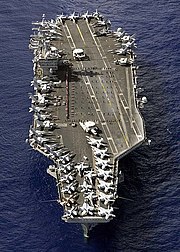History
Naval warfare developed when humans first fought from water-borne vessels.
Prior to the introduction of the cannon
and ships with sufficient capacity to carry the large guns, navy warfare
primarily involved ramming and boarding actions. In the time of ancient Greece and the Roman Empire, naval warfare
centered on long, narrow vessels powered by banks of oarsmen (such as triremes and quinqueremes) designed to ram and sink enemy
vessels or come alongside the enemy vessel so its occupants could be attacked
hand-to-hand. Naval warfare continued in this vein through the Middle Ages until cannon became
commonplace and capable of being reloaded quickly enough to be reused in the
same battle. The Chola
Dynasty of medieval India was known as
a one of the greatest naval powers of its time in the Indian Ocean. In ancient China, large naval
battles were known since the Qin
Dynasty (also see Battle of Red Cliffs, 208), employing the war junk during the Han Dynasty. However, China"s first official
standing navy was not established until the Southern Song Dynasty in the 12th century, a time when gunpowder was a revolutionary new
application to warfare.
The mass and deck
space required to carry a large number of cannon made oar-based propulsion
impossible and ships came to rely primarily on sails. Warships were designed to carry increasing numbers
of cannon and naval tactics evolved to bring
a ship"s firepower to bear in a broadside, with ships-of-the-line arranged in a line of battle.
The development of large capacity, sail-powered ships carrying cannon led to
a rapid expansion of European navies,
especially the Spanish and Portuguese navies which dominated in
the 16th and early 17th centuries, and
ultimately helped propel the age of exploration and colonialism.The repulsion of the Spanish Armada (1588) by the Anglo-Dutch fleets revolutionized naval
warfare by the success of a guns-only strategy and caused a major overhaul of
the Spanish
navy, partly along English lines,
which resulted in even greater dominance by the Spanish. From the beginning of
the 17th century the Dutch cannibalized the Portuguese Empire in the East and, with
the immense wealth gained, challenged Spanish hegemony at sea. From the 1620s, Dutch raiders seriously troubled Spanish shipping
and, after a number of battles which went both ways, the Dutch Navy finally broke the long
dominance of the Spanish Navy in the Battle of the Downs (1639).
England emerged as a major naval
power in the mid-17th century in the first Anglo-Dutch war with a technical victory but
successive decisive Dutch victories in the second and third Anglo-Dutch Wars
confirmed the Dutch mastery of the seas during the Dutch Golden Age, financed by the expansion of
the Dutch Empire. The French Navy won some important
victories near the end of the 17th century but a focus upon land forces led to
the French Navy"s relative neglect, which allowed the Royal Navy to emerge with an ever-growing advantage
in size and quality, especially in tactics and experience, from 1695. Throughout the 18th century the Royal Navy gradually gained
ascendancy over the French Navy, with victories in the War of
Spanish Succession (1701-1714), inconclusive battles in the War
of Austrian Succession (1740-1748), victories in the Seven Years" War
(1754-1763), a partial reversal during the American War of Independence (1775-1783),
and consolidation into uncontested supremacy during the 19th century from the Battle of
Trafalgar in 1805. These conflicts saw
the development and refinement of tactics which came to be
called the line of
battle.
The next stage in the evolution of naval warfare was the introduction of metal plating along the hull sides. The
increased mass required steam-powered engines, resulting in an arms race between
armor and weapon thickness and firepower. The first armored vessels, the French
FS Gloire and British HMS
Warrior, made wooden vessels obsolete. Another significant
improvement came with the invention of the rotating turrets, which allowed the
guns to be aimed independently of ship movement. The battle between the CSS Virginia and the
USS Monitor during
the American Civil
War is often cited as the beginning of this age of maritime conflict. A
further step change in naval firepower occurred when the United Kingdom launched
HMS
Dreadnought, but naval tactics still
emphasized the line of battle.
The first practical military submarines were developed in the late 19th century
and by the end of World War
I had proven to be a powerful arm of naval warfare. During World War II the German Navy"s submarine fleet
of U-boats almost starved the United
Kingdom into submission and inflicted tremendous losses on US
coastal shipping. The German battleship Tirpitz, a
sister ship of the Bismarck, was almost put out
of action by miniature submarines known as X-Craft. The X-Craft severely damaged her and
kept her in port for some months.
A major paradigm shift in naval warfare occurred with the introduction of the
aircraft carrier.
First at Taranto
in 1940 and then in Pearl Harbor in 1941, the carrier demonstrated its ability to strike
decisively at enemy ships out of sight and range of surface vessels. The Battle of Leyte
Gulf (1944) was arguably the largest naval battle in
history; it was also the last battle in which battleships played a
significant role. By the end of World War II, the carrier had become the dominant
force of naval warfare.
World War II also saw the United States become by far the largest Naval
power in the world with over 70% of the world"s total numbers and total tonnage
of naval vessels of 1000 tons or greater.[1]
Throughout the rest of the 20th century The United States Navy would maintain a tonnage
greater than that of the next 17 largest navies combined.




